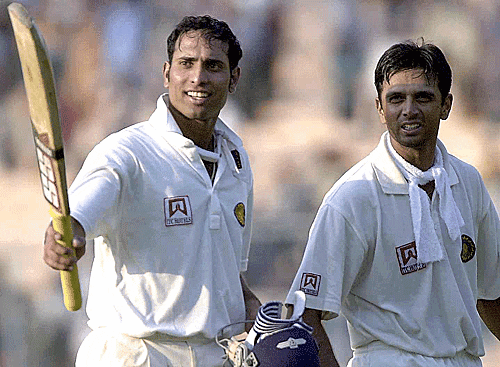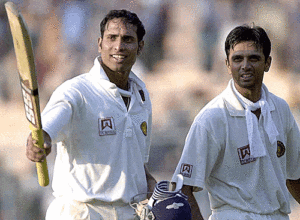
It’s Wednesday night and you’ve crossed the halfway mark of the week. It’s been a bad 3 days so far and you’re just trying to push yourself to the weekend that now seems a day closer than it did yesterday. Equate your work week to a 5 day cricket Test match. Whenever I’ve had a less than average week, I draw my strength from a particular 5 day cricket Test match that happened more than 10 years ago. Let me explain this magical piece of history.
The month is March, the year 2001, the city Kolkata. The harsh Indian summer is turning the corner, but its presence can already be felt. The Australian cricket team is in the middle of their tour of India and in the midst of overcoming the “final frontier”, as then captain Steve Waugh referred to the Indian tour. They had been doing pretty well, going into the second Test after having whipped India in the first one.
Day 1 went decently enough for both teams with Australia finishing on 291/8. India were looking to quickly mop up the tail, but Steve Waugh and Jason Gillespie thought otherwise. They put on a dogged partnership of 133 runs and Australia scored 445 in their first outing. India came out, were immediately in trouble and the rot never stopped for the rest of the day as they finished Day 2 on 128/8. VVS Laxman quickly gathered some runs in a last wicket stand of 42 as India were bowled out for 171 in their first innings, behind Australia by 264 runs and forced to follow on as they stared down the barrel at an imminent Test and series defeat. India came out for their second essay and, although they did better, lost key wickets along the way. They finished Day 3 at 254/4, still 10 runs behind Australia and VVS Laxman and Rahul Dravid, the last 2 specialist batsmen for India, at the crease.
VVS Laxman looked to be in good touch. He had scored 59 runs in the first innings before he became the last Indian wicket to fall. At the end of Day 3, he was unbeaten on 109. Rahul Dravid however, looked to be out of sorts, like all the other Indian batsmen had so far. He had managed just 25 runs in the first innings and had finished Day 3 unbeaten on 7, having just come in. So far, the entire Test, and series till that point, had been Australia all the way. They had simply walked all over India and the footprints were deep. Then Day 4 happened.
Exactly 90 overs were bowled by the Australians that day. Exactly 335 runs were scored by the Indians that day. Exactly 0 wickets fell that day. That was the day that changed VVS Laxman’s initials from Vangipurappu Venkata Sai to Very Very Special, a nickname he carries with aplomb and lives up to to this day. Laxman added 166 runs to his overnight score of 109, finishing Day 4 unbeaten on 275. Rahul Dravid epitomised his nickname of “The Wall”, adding 148 runs to his overnight score of 7, entering the pavillion unbeaten at the end of Day 4 on 155.
Australia, who had been eyeing and smelling a victory at the start of Day 4, achieved possibly by the end of day’s play, had spent the entire day in the field without a single success and were now actually facing a possible defeat as they trailed the Indians by 325 runs with Laxman and Dravid still at the crease. The crowds, who hadn’t really bothered coming in at the start of play on Day 4 but later turned up in surging waves as the news of Laxman and Dravid spread, were jostling and fighting to acquire a ticket to see an improbable Indian victory on Day 5, snatched from the jaws of defeat by 2 Indians against an army of 11 Australians, Spartan-like.
Laxman fell early on Day 5 as India sought to press their advantage. He had amassed a mammoth 281, the highest score ever by an Indian in Test cricket. He had single-handedly wiped out the first innings deficit of 264. Rahul Dravid fell soon after, trying to up the tempo. He had scored 180 and was an equal hero. Between the two of them, they racked up some voluminous statistics and records. They shared a partnership of 376 runs, scored a total of 461 runs, faced a total of 805 balls or 134.1 overs and spent a total of 1077 minutes or 17 hours 57 minutes at the crease. Phew!
India declared in about an hour on Day 5 at 657/7, setting the Australians a massive target of 384 with about 75 overs left in the day’s play. The required run rate was well above 5 runs an over, a near impossible task in Test cricket, especially when your back’s against the wall. That meant that India were in the clear. They were almost definite of a draw, but they were looking at a win. 10 wickets in 75 overs meant a wicket every 7.5 overs, a most definitely achievable task, especially with the Indians having their tails up and baying for Australian blood on a crumbling fifth day pitch.
Australia started solidly enough and the openers thwarted the Indians for nearly 2 hours before the first wicket fell. A half hour later, two more had fallen. Captain Steve Waugh and opener Matthew Hayden, the two top scorers for Australia in their first innings, set about their task of not getting out. Over an hour later, the two of them were still at the crease. With just 30 overs left in the day and 6 wickets to scalp, at an average of a wicket every 5 overs, and with impossibly difficult batsmen in the form of future captain Ricky Ponting, wicketkeeper Adam Gilchrist and bowler-who-just-won’t-get-out Jason Gillespie, an Indian victory was starting to look more than just a tad hard to achieve. But we couldn’t have a draw after all that has happened, after all that our 2 brave Spartans had done the previous day. And that was when the Turbanator decided it was time he stepped up to the plate, again.
Harbhajan Singh was another man for whom the series provided a nickname, earned for his exploits with the ball and his turban. He had picked up 7 wickets in Australia‘s first innings and decided that a sequel was in order. He got rid of Steve Waugh and Ricky Ponting in the same over. That opened the floodgates. Sachin Tendulkar, who had had a rotten Test till then, sent back Adam Gilchrist in the next over and then accounted for Matthew Hayden 2 overs later. In less than 20 deliveries, Australia had gone from a potential drawing position at 166/3 to a headlong free fall into defeat at 173/7. 2 overs later, Tendulkar removed Shane Warne and Australia were tottering at 174/8 with another 25 overs left in the day. The Australian quickies tried to put up a brave front as they fought tooth and nail to stay at the crease for another ball, hoping against hope that they could last out the day. But it was just delaying the inevitable. The last Australian wicket fell about a half hour from the close of play. The Turbanator had sent home 6 Australian batsmen.
India had won a miraculous Test match, becoming only the third team in Test cricket’s 137 year history, and the first in nearly 20 years, to win a Test match after following on. VVS Laxman was deservedly named Man-of-the-Match for having turned the Test match on its head with one unbelievable magical knock. That one day, Day 4 of Test 2, turned the series around. India became the dominant team and won the third Test as well to wrap up an improbable series win.
What does all this have to do with work? Well, the next time you find yourself in the middle of the week cursing another rotten week at work, just think to yourself: “Day 3 of the week, Wednesday, is over and day 4 of the week, Thursday, is about to begin. And I’m an Indian.”
Note: Much thanks to Cricinfo for all the numbers.

Be the first to comment